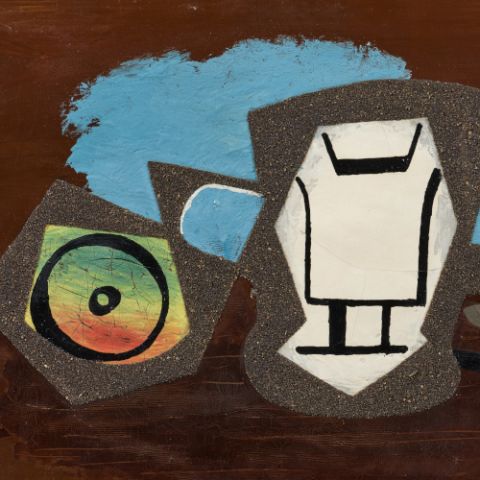
Lot 26 | Pablo Picasso | Pomme et Verre
1881 Malaga - 1973 Mougins
Title: Pomme et Verre.
Date: 1923.
Technique: Oil and sand on canvas.
Measurement: 22,5 x 28cm.
Notation: Signed and dated lower right: Picasso 23.
Frame/Pedestal: Craftman's frame.
Provenance:
- Paul Rosenberg, Paris
- Jaques Helft, Paris, New York and Buenos Aires
- Sotheby's London, auction 27th November 1995, lot 36
- Konrad Klapheck Collection, Düsseldorf
- Private collection Germany
Literature:
- Zervos, Christian: Pablo Picasso - Vol. 5, Works from 1923 to 1925, Paris 1952,
cat. rais. no. 68, ill.
- Rare Picasso painting on the German auction market
- From the former previous possession of Konrad Klapheck
- The still life shows a fundamental development of Picasso's unique approach to Cubism
The beginning of deformation
Although Pablo Picasso had already turned away from Cubism by 1923, the year “Pomme et Verre” was created, the work is still strongly influenced by this epochal style. As the founder and main representative of Cubism, Picasso, together with Juan Gris, introduced a radical way of representing reality and broke away from traditional art.
With his pioneering work “Demoiselles d'Avignon” (1907), Picasso had already broken with the laws of perspective that had been followed since the Renaissance and dissected the figures into geometric elements. Influenced by archaic art, African sculpture and the compositional principles of Paul Cézanne, who used simple forms such as cylinders, spheres and cones to depict nature, Picasso began to break up the unity of the closed form subject to a single vanishing point in analytical cubism and to fan out the body volume into multiple facets. Systematically dealing with the subject required the destruction of its true-to-life image, although the representation without illusionistic deception resulted in a necessary deformation (Fig. 1). Freed from the central perspective of the figure, the individual internal forms of a body now appear like rhythmic cubic splinters and unfold their own dynamics in the pictorial space, detached from the perspective order.
On this basis, Picasso and his artist colleagues Georges Braque and Juan Gris took a further step in Synthetic Cubism. Here, the loose and compositionally unconstrained arrangement of these liberated pictorial elements takes place: the independence of the facets, the splinters.
Independent fragments and pictorial quotations
In collages, they acquire a relief-like surface through the integration of paper, newspaper, wallpaper, imitation wood grain, sawdust and sand. With this increasingly independent existence and the associated suspension of the conventional figure-ground relationship, they open up an additional dimension: the object-like, material reality of the image comes to the fore.
The composition “Pomme et Verre” is neither structured in perspective nor modeled in a painterly way. Instead, the stenciled pictorial elements lie next to each other like fragmented color fields. Due to the indistinguishable interpenetration of foreground and background, the components of the still life, some of which are difficult to recognize, become entangled in the surface: the plate and jug stand out in silhouette as a field structured by grains of sand in gray against the brown of the table top and tray, which are atmospherically backed by an unidentifiable sky blue. On this field, in turn, the apple and glass stand out as if glued on. The surface has lost all sense of volume, its highly simplified forms are set with a few black lines on the cropped background, which alternates between red and green here and is kept pure white there. This makes them look more like abstract drawings: is the glass depicted a glass or rather a drawing of a glass? The ambiguous “picture in picture” quote blurs the reference to reality. In this still life, which is reduced to the essential with playful sovereignty, Picasso makes it clear that the reality of the subject of the picture not only differs from the reality of the object, but on the level of representation itself remains a mere abstract suggestion and thus ambiguous.
Bettina Haiss.
Modern, Post War & Contemporary Art
+49 221 92 58 62 300
Print this lot | Recommend lot |
Conditions of this Lot
32% buyer’s premium on the hammer price
Estimated shipping costs for this lot:
Arrangement after the auction.
Pablo Picasso Spain Cubism Surrealism Modern Art 1920s Craftman's frame Still Life Painting Oil and sand Fruits




